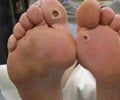A team of scientists at the David Geffen School of Medicine at UCLA have solved the structure of a class of proteins known as sodium glucose co-transporters (SGLTs), which pump glucose
Improved treatments for diabetes, obesity and cancer may be on the anvil after scientists at the David Geffen School of Medicine at UCLA claimed to have solved the structure of a class of proteins known as sodium glucose co-transporters (SGLTs), that help pump glucose into cells.
These transport proteins are used in the treatment of chronic diarrhea via oral rehydration therapy, saving the lives of millions of children each year.The research team, led by Jeff Abramson and Ernest Wright of the UCLA Department of Physiology, produced an 'atomic snap shot' of an SGLT protein.
With the help of a specialized technique known as X-ray crystallography, the researchers generated the first high-resolution, three-dimensional picture of a glucose transport protein.
"This was a very challenging study that required innovation at each step of the process," said Abramson.
"We literally had to invent new approaches to entice the protein into a crystal and then spent years optimizing these crystals to reach a quality suitable for visualization by X-rays. This would not have been possible without high-throughput protein production and purification capabilities," he added.
A tantalizing observation made during the determination of the glucose transporter structure was the possibility for structural similarities with a previously crystallized neurotransmitter transporter molecule.
Advertisement
These results provide a fundamental understanding of how membrane proteins function in a dynamic manner.
The new findings will dramatically enhance the ability to rationally design these drugs.
Currently, Wright and Abramson are examining the manner in which inhibitors of the transporter proteins modulate function with the goal of facilitating better drug design for the treatment of diabetes, obesity, and cancer.
The study is published in an online edition of the journal Science.
Source-ANI
RAS/S












